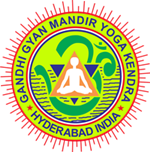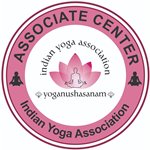- Parts of the body
- 1. Sense organs (Gyanendriyas)
- 2. Working organs (Karmendriyas)
- 3. Brain and nervous system
- 4. Heart and blood circulatory system
- 5. Respiratory system
- 6. Muscular system
- 7. Stomach, digestive system
- 8. Skeleton
- 9. Main glands
- 10. Kidneys
- 11. Reproductive organs
- 12. Excretory system
- PanchKoshas
All believe that human life is the supreme one in the nature. Man’s physical appearance is the body. The five elements, earth, water, fire, air and ether (space) are the sources of the composition and for the existence or the survival of the body. When soul leaves, the body again reunites the five elements. But as long as the soul is in the body the feeling of my body, it is me and such other attachments won’t leave. That is why man always tries to maintain and protect the body. As a result of such tales only, medical science, various therapies, Yoga etc. have emerged. Yoga knowledge helps a lot in cleaning and maintaining not only the external parts of the body but the internal organs also.
Parts of the body:
Human body is mysterious and wonderful. The body may broadly be divided into 12 parts according to their functions.
They are:
1. Gyanendriyas Sense organs
2. Karmendriyas Working organs
3. Brain and nervous system
4. Heart and blood circulatory system
5. Lungs and respiratory system
6. Muscular system
7. Stomach, digestive system and body maintenance
8. Skeleton – Bones and skeletal system
9. Main glands and endocrine system
10. Kidneys and excretory system
11. Reproductive organs
12. Other excretory organs
Yoga exercises have an impressive impact on all the above organs and systems of the body. Yoga knowledge helps us keep our body healthy by following the principle of nature without using any medicines.
Two types of activities take place in our body;
1. Activities that are controlled by our will and wish
2. Activities that take place automatically without our knowledge, whether we wish or not they go on functioning.
Activities such as walking, standing, sitting, rising, sleeping, talking etc., take place according to our will and wish.
Activities such as heart beating, pulse beating, breathing, winkling of eye lids, digestion, blood circulation etc. take place automatically without our deliberate efforts.
Mind controls all the activities of the first category, knowledge controls the mind. The self (ego) controls the knowledge. Atmathe soul controls all of them.
It is necessary to have a brief knowledge of parts and organs of our body.
1. Sense organs (Gyanendriyas):

Ears, skin, eyes, tongue and nose are the sensary organs. These five sensary organs work for the five elements of nature, the earth, water, fire, air and ether (the space). The quality of the earth is to emit the smell, we smell through our nose. The quality of water is juice (liquid), we taste through our tongue. The quality of fire is light, we see the light through our eyes. The quality of the air is to make us feel, we feel through our skin. The quality of the ether (sky or space) is to produce sound, we hear through our ears.
2. Working organs (Karmendriyas):
We have five karmendriyas mouth, hands, legs, reproductive organs and excretory organs. We all know their functions and importance very well.
3. Brain and nervous system:

Brain is in the head. The brain is like the inner part of a wall nut. The nerves are spread through out the body and make the body function. Cranial nerves, spinal nerves and many other micro nerves start in the rear of the back bone and spread through a nerves net work and terminate in the brain. The power and activeness of the body.
4. Heart and blood circulatory system:
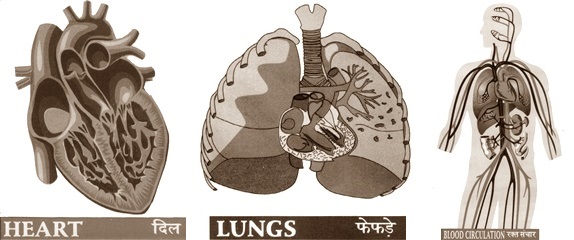
The size of the heart of a person is almost as the size of his fist. It is below the left breast. We feel heart beat while we run and climb steps or when we are afraid of some thing etc. We feel that the heart beats increase. Arteries carry pure blood to different parts of body and veins carry impure blood back to heart. A number of arteries and veins are there. There are four chambers in the heart. Two ventricles and two auricles. They always contract and release and push blood to different parts of the body.
A healthy person’s heart beats 70 to 75 times per minute. It goes on working as long as a person is alive. A person may become a victim of dangerous diseases when either the blood circulation is not proper or some waste is accumulated in the blood. If Pranayaam and other related Yogas are practiced regularly, heart pain and other heart complaints can be averted.
5. Respiratory system:

We breath through our both the nostrils. The air enters the lungs through the wind pipe. A healthy person breathes 15 or 16 times per minute. Those who do hard work, physical exercises, the breath rate increases. When a person is sick he feels his breath rate increased. Heart pumps the blood to lungs where it is purified by taking in oxygen and breathing out carbon dioxide + little water.
In Yoga Shashtra, breathing, the air in, is called ‘Puraka’ (inhale), holding the breathed air in the lungs is called “Kumbhaka’ (retention) and the air breathed out is called ‘Rechaka’ (exhale). Puraka, Kumbhaka and Rechaka, the three breathing activities have great importance in Yoga Shashtra.
6. Muscular system:
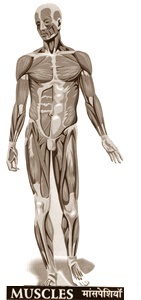
The movement in the body is the result of the muscular system. The bones are covered with muscles. Muscles are composed with a number of cells. The muscles of wrestlers are big and powerful, but the muscle of Yoga practitioners are strong and normal. The muscle fibres forming flesh bundles together help in all physical activities like walking, moving, talking etc. Muscles play an important role in circulation of blood for all the organs of the body, in regulating the respiratory system etc. Muscles are of different shapes and sizes in different parts of the body. Veins and arteries are spread like a net in the flesh. Muscles contract, relax and again come to their original size. If fat accumulates on the muscles it leads to various complications including heart diseases. After child birth and after certain age excess fat accumulated in the body especially hips, waist, thighs etc.,. This fat can be reduced by Yoga practice.
7. Stomach, digestive system and body maintenance:
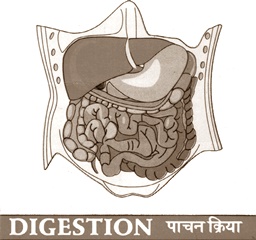
The main functions of the stomach is to properly digest the food that we take and supply the nutrition to body.
Parts of digestive system:
Mouth, esophagus (food pipe), stomach, duodenum, liver, gall bladder, pancreas, small intestine, large intestine, rectum, anus are the organs of the digestive system.
Stomach is the source for a number of diseases. If the stomach is healthy and functions properly one need not worry about the health throughout his life.<
Food pipe:
The food pipe is generally 25 cms long. It starts in the throat and ends in the stomach. There are certain glands to the inner side of the wall of the pipe. It is like a thin long cylinder. It is made of muscles. There are no bones in it. The food is mixed with saliva in the mouth and is turned into pulp. This pulp reaches the stomach passing through the food pipe.
Stomach:
The food pipe ends in the stomach. The stomach wall is thick. There are gastric juice producing glands in the stomach. Bile which acts on the food in the stomach and helps in its digestion. It supplies the required nutrition to all the parts of the body.
Liver:

Liver is the largest gland in the human body. It is red in colour. It is safe in the right side below the ribs. It weighs between one to one and half kilograms. It produces bile. Bile helps in digestion of fat. Liver converts the impurities of the blood into urea and sends it into the kidneys. The kidneys filter the urea and send it into the urinary bladder along with the urine. The poisonous matter produced in the intestine is converted into non-poisonous matter. This is the marvelous function of the liver. The liver of the liquor consumers is spoiled quickly and they become the victims of various diseases.
Spleen: (Not a part of digestive system)
This is a twelve centimeter gland. (It circulates the blood to the stomach and teeth). It generates red blood corpuscles. It is in the shape of a sack on the upper part of the Coram gland. If it is removed by operation to cure any disease man can even then survive.
Small intestine:
The small intestine is five times longer than the height of the person. It starts in the lower part of the stomach and knits itself zig zag in the abdomen and joins the large intestine. The outer side of the wall of the intestine is very delicate. The inner side of the wall of the intestine has villi. The villi absorbs the digested food and send it into the blood.
Large intestine:
The length of large intestine is equal to the height of the person. It starts in the right lower part in the abdomen at the end of the small intestine. It proceeds upwards and turn to left and then proceeds downward and ends in the anus. The undigested and waste material of the digestive system is excreted through the large intestine in the shape of stool. If the waste remains in the large intestine it leads to constipation.
A number of Yogasanas and stomach cleaning processes are prescribed for protecting and for the functioning of the digestive system effectively. If we implement and follow them the stomach diseases or complications will not take place.
8. Skeleton:

The human body is shaped on the skeleton. It is formed with strong bones. There are 206 bones in the skeleton – 22 in the skull, 52 in the trunk, 126 in the limbs, 6 in the ears. Back bone is there in the center of the back, below the neck. It has 33 delicate bones which are called vertebra. Back bone is the prime basis for a strong body.
There are three major parts in the skeleton.
1. Skull
2. Trunk; and
3. Limbs (hands or legs)
Out of 52 bones in the trunk, a cage is formed with 24 ones in the chest. Delicate organs like lungs, heart and liver are safely protected in this cage. Major part of the Yogashastra deals with the Asanas that help in strengthening the back bone.
9. Main glands:
There are total 108 small and large glands in the human body. Let us know briefly about few important glands:
Pineal gland:
This gland has a great impact on the brain. If this gland functions well, man can think correctly. It provides energy, efficiency and activeness to the human body.
Pituitary gland:
This starts at the bottom of the head proceeds down ward and joins the navel system. This gland influences bones and muscles. This also contributes for the normal functioning of uterus in women and testicles in men. This is the gland that helps in producing milk in the breast of a mother soon after the delivery.
Thyroid gland:
This gland is in the throat. It maintains harmones in the body, it strengthens the digestive activities, increases appetite, strengthens the masculine potency, develops the reproductive organs. Any disorder or discrepancy in this gland will lead to the fattening of the body. Fat body causes more inconveniences and troubles in the day to day activities of the life.
Pancreas:
If pancreas does not function well, sugar increases in the blood and passes in urine, leading to diabetes. As long as pancreas functions well sugar (glucose) level is maintained in the blood and body is safe from diabetes.
This is in the center of the abdomen behind the stomach. It secretes digestive juice + insulin. It increases appetite and also increases life span and energy. Insulin controls blood sugar level by helping in digestion + utilization of glucose.
Adrenal gland:
This gland is placed at the upper end of kidneys. It helps in the proper functioning of the blood circulatory system.
Semen gland:
This gland is below the testicles in men. This helps in the development of male reproductive organ and in the production of semen.
A number of specific Yogasanas are prescribed to activate and strengthen each of the above glands.
10. Kidneys:
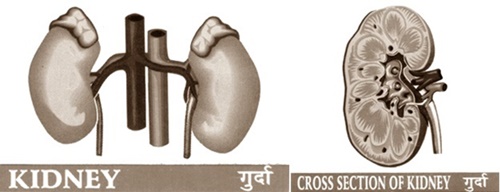
Kidneys remove the impurities and the wastes that accumulate in the body. (The impurities and wastes are let out through skin, kidneys, anus and urinary parts. Impurities in the shape of sweat are let out through the skin). Kidneys filter the blood plus form urine and the residue is passed out through urinary organ. If Kidneys don’t function properly, they are removed and healthy kidneys are transplanted in their place. Yoga practice helps a lot in making kidneys function well throughout the life.
The kidneys are on either side of the backbone. They are covered with fat. (There is a sack like organ on the kidneys. Hormone juice is produced by it). Two tubes come from the kidneys and join the urinary bladder. Urine is collected in the bladder. When the bladder is filled we feel to urinate.
Kidneys also contribute in the purification of blood. Urea and uric acid is present in the blood that comes into kidneys. They go out in the form of urine. But in some kidneys urea and uric acid don’t pass out of the kidneys, they remain there and gradually form stones in the kidneys. They should be removed immediately as and when detected. Many kidney diseases are found these days. These diseases can be prevented by practicing specific Yogasanas.
11. Reproductive organs:
Reproductive organs of male and female are the sources for human generation. They are very delicate. Their shapes are different in male and females. Female has a uterus inside the lower part of the body. Uterus make a woman mother when the sperm cells of male and ovary cells of female join, the woman becomes pregnant and gives birth to an infant. This is also a Yoga.
Specific Yogasanas and Yoga exercises are prescribed for the development, protection and health of the external and internal reproductive organs.
12. Excretory system:
a. Kidney
b. Skin (Sweat glands)
c. Small and large intestine through anus
Sending the impurities and the wastes from the small and large intestines through anus is the main function of excretory system. If this system does not function properly, a number of complications and diseases start in the body. Certain Yoga activities and Yogasanas are specified for the proper functioning of the excretory system.
![]()
The knowledge of the different parts and organs of human body and their functions helps us to keep them healthy and active, thereby we can avoid complications and protect ourselves from diseases.
According to ancient shastras and research/experience of yogis, the man is described as being composed of five areas of existence, termed as Panch Koshas in the Yogic terminology as follows:
1. Annamaya Kosha (Food body) experienced as physical body
2. Pranamaya Kosha(Pranic body) experienced on physiological function
3. Manomaya Kosha (Mental body) experienced as mental and emotional process
4. Vignanamaya Kosha (Intutive body) experienced as psychic dimensions and
5. Anandamaya Kosha (Bliss body) experienced as transcendental awareness
These five Koshas constitute every human being in complete, whereas the physical body is only a fractional existence, that is seen.
Yoga practice helps to purify and tone up all the above Pancha Koshas i.e. the five bodies of every Sadhak.
![]()
